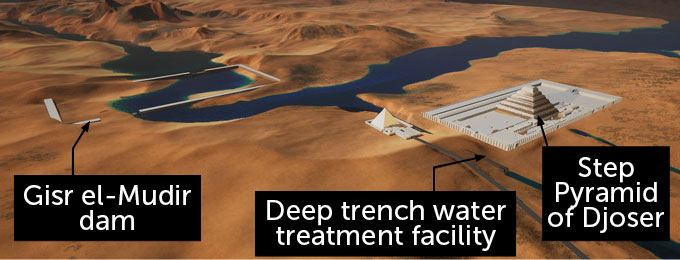Waterpower may have given a big lift to builders of Egypt’s oldest known pyramid, the nearly 4,700-year-old Step Pyramid of Djoser at Saqqara.
Ancient architects built a hydraulic system for hoisting stone blocks that were used to assemble King Djoser’s six-tiered, roughly 62-meter-tall pyramid, scientists propose August 5 in PLOS ONE. Controlled flows of water into and out of a large shaft inside the pyramid lifted and lowered a platform that carried loads of building stones to higher levels, say Xavier Landreau of the private Paris research institute Paleotechnic and colleagues.
The idea is intriguing, say researchers familiar with the study. But they are not convinced that pyramid builders ever used such a device. Landreau, who has a background in materials science and plasma physics, founded Paleotechnic for the study of ancient technologies.
No generally accepted explanation exists for how ancient Egyptians erected pyramids out of millions of massive blocks. Those stones could weigh up to around 2,500 kilograms each. Proposed techniques for maneuvering pyramids’ building blocks include ramps, cranes, rope-and-pulley devices and rolling wooden rods attached to stones (SN: 9/9/14).
In a report published earlier this year, another research team described a newly identified, now dry Nile tributary that borders a chain of 31 pyramids, including Djoser’s. Vessels containing workers and building materials could have plied this Nile branch to dock near sites where those pyramids were built between around 4,700 and 3,700 years ago.
Water played an even bigger part in building ancient Egypt’s first pyramid, Landreau says. He contends that designers of Djoser’s pyramid deftly engineered techniques for controlling water flow, a field of knowledge now known as hydraulics.
How the pyramid hydraulic system may have worked
The proposed hydraulic system derives from a computer model that included data on surviving internal features of the pyramid and a network of underground tunnels at the site. The team also used high-resolution satellite images of the region’s landscape to model ancient rainfall and runoff levels.
In their model, a walled enclosure several hundred meters from the pyramid — first described in the 1700s but still poorly understood — captured floodwater that flowed through desert channels during periodic heavy rains. Structures in the walls of the enclosure, known as Gisr el-Mudir, directed the water to a basin just west of Djoser’s burial grounds. Periods of intense rain may have temporarily turned that basin into a lake, which then drained into a section of a limestone trench that encircled the burial complex.
Researchers have previously proposed that the trench, known as the Dry Moat, served as a quarry for Djoser’s burial complex or as a model of the deceased pharaoh’s path to the afterlife.

But Gisr el-Mudir and its nearby lake ensured that the Dry Moat was not always dry in Djoser’s time, Landreau says. In the team’s model, water from the Dry Moat entered two large, previously excavated shafts, including a north shaft situated inside the pyramid. Granite chambers near the bottom of both shafts contained stone plugs that, when removed, allowed water to rush in.
The north shaft is the framework for a hydraulic lift, the team proposes.
In this hypothetical setup, a massive wooden float rested above the granite chamber. The float was attached to two or more long ropes that passed over separate pulleys at the top of the shaft before looping around to attach to a lift platform. Ancient engineers would have designed the float and lift platform to counterbalance each other as water filled or drained from the shaft, the researchers hypothesize.
Access points to the lift platform for workers hauling building stones were located either at ground level or possibly through a tunnel that may have been located several meters above ground level, Landreau’s team suspects.
As water filled the shaft through the granite chamber, the float rose and the platform descended. Water was shut off when the platform reached the loading area. After placing tons of stones on the platform, the shaft was drained. As the float descended, it pulled on the ropes, yanking the platform and its cargo up to new construction levels.
Why the pyramid hydraulics idea may not hold water
That’s an unlikely scenario, says University of Toronto archaeologist Oren Siegel. Gisr el-Mudir could not have held enough water from occasional rains to maintain Landreau’s proposed hydraulic system, he argues. Gisr el-Mudir may instead represent an early experiment in building stone enclosures that would later, on a larger scale, surround pharaohs’ burial sites, Siegel suggests.
Another complication involves the proposed lake, says Egyptologist Kamil Kuraszkiewicz: It’s not mentioned in any ancient Egyptian writings and may never have existed.
Also, Djoser’s pyramid stones — which weighed on average about 300 kilograms each — were considerably smaller and easier for workers to transport than those used for later pyramids, says Kuraszkiewicz, of the University of Warsaw. “To build the hydraulic device [proposed in the new model], much more effort would be needed than to move the stone blocks using just manpower.”
Landreau calls for further research at Djoser’s pyramid. It’s not known how high the partially excavated north shaft extended, limiting the ability to model a possible hydraulic lift system, he says. But he predicts that stonework on the shaft sides would have supported a structure that rose beyond its known length of about four meters aboveground.
#Egypts #pyramid #built #hydraulics #theory #hold #water
Image Source : www.sciencenews.org